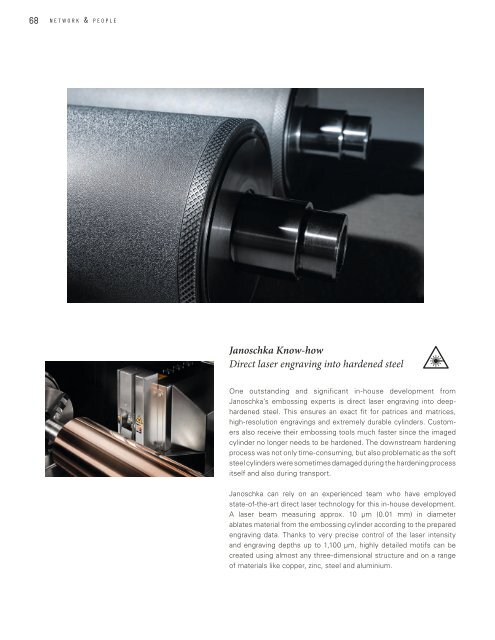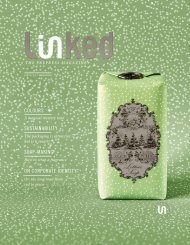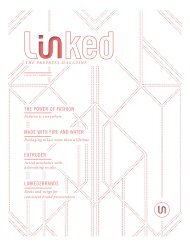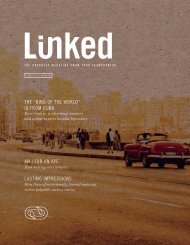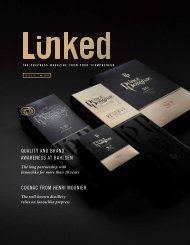Janoschka magazine Linked_V8_2023
The customer magazine by Janoschka and Linked2Brands.
The customer magazine by Janoschka and Linked2Brands.
Create successful ePaper yourself
Turn your PDF publications into a flip-book with our unique Google optimized e-Paper software.
68 n e t w o r k & p e o p l e<br />
issue #8 ©<br />
l i n k e d<br />
69<br />
WE HAVE ALL SEEN WORM<br />
AND LINEN PATTERNS ON YOGHURT<br />
POT LIDS. WHAT ARE THEY FOR?<br />
<strong>Janoschka</strong> Know-how<br />
Direct laser engraving into hardened steel<br />
One outstanding and significant in-house development from<br />
<strong>Janoschka</strong>’s embossing experts is direct laser engraving into deephardened<br />
steel. This ensures an exact fit for patrices and matrices,<br />
high-resolution engravings and extremely durable cylinders. Customers<br />
also receive their embossing tools much faster since the imaged<br />
cylinder no longer needs to be hardened. The downstream hardening<br />
process was not only time-consuming, but also problematic as the soft<br />
steel cylinders were sometimes damaged during the hardening process<br />
itself and also during transport.<br />
<strong>Janoschka</strong> can rely on an experienced team who have employed<br />
state-of-the-art direct laser technology for this in-house development.<br />
A laser beam measuring approx. 10 µm (0.01 mm) in diameter<br />
ablates material from the embossing cylinder according to the prepared<br />
engraving data. Thanks to very precise control of the laser intensity<br />
and engraving depths up to 1,100 μm, highly detailed motifs can be<br />
created using almost any three-dimensional structure and on a range<br />
of materials like copper, zinc, steel and aluminium.<br />
Daniela Heidt: Yes, you will<br />
have done. That kind of threedimensional<br />
shaping across the<br />
whole surface makes yoghurt<br />
lids stronger, for example. It<br />
allows several pots to be stacked<br />
on top of each other in<br />
supermarket refrigerators. In<br />
addition, the structure makes<br />
the material itself more durable<br />
and therefore also helps the<br />
contents last longer. Without<br />
this surface structure the lids<br />
would either have to be thicker<br />
or backed with another (composite)<br />
material to achieve a<br />
similar loading capacity and<br />
robustness. So this technique<br />
meets sustainability requirements<br />
on several levels, too.<br />
Matthias Heidt: This form of<br />
embossing also has important<br />
functions during the production<br />
process itself: the reliefs<br />
act as spacers to a certain extent<br />
so that the aluminium foil<br />
lids rest loosely on top of each<br />
other. This in turn allows the<br />
filling machine to separate the<br />
individual lids more easily<br />
when it seals them onto the<br />
pots. Without the embossed<br />
structure, the very smooth<br />
pieces of metal foil would lie<br />
so compactly that the machine<br />
would not be able to separate<br />
and apply them so easily. This<br />
would cause production holdups<br />
and increase costs.


